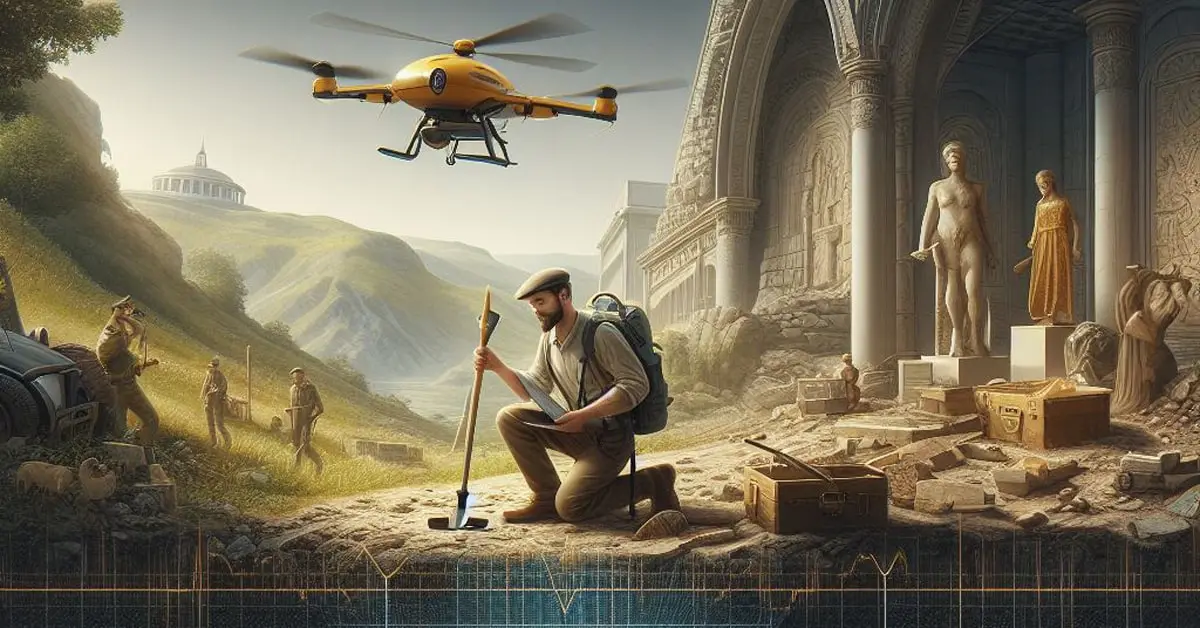This article is for archaeology enthusiasts who did not understand ‘what is archaeology’ in the previous article. Hence, this article includes an extended answer with descriptive explanations and examples for the questions: What is archaeology? and how to understand archaeology? Most importantly, to understand processual archaeology and post-processual archaeology, we need to have a better understanding than knowing a definition of archaeology.
Additionally, the answers to these questions—why the development of a definition should be studied, what a definition is, and how studying a definition helps to improve understanding—will be explained with examples. On that basis, the definition of archaeology would be explained step by step. The goal of this descriptive article with examples is to simplify and explain:
- how important it is to study the definition of archaeology,
- how can the definition of archaeology be studied, and
- How does studying the definition of archaeology help to improve our understanding of archaeology as much as possible?
Current Definition of Archaeology
According to the current definition, archaeology is the study of past human culture, past human behaviour, and past human cognition through material remains left from the past. To better understand what archaeology is, we can study this definition. To do that, we need to look at how it developed over time. Before that, we should understand what a definition is.
What is a definition?
Everything natural and manmade that occurs around and within human beings can be put into two categories:
- tangibles (physically touchable) and
- intangibles (physically untouchables)
All things, including people, places, things, energy, concepts, actions, or situations, may be categorised under these two categories. Whatever it is, all the time, each of them has
- a name (a term) referring to them,
- a definition describing their name or term, and
- interpretations, describing and explaining them.
These terms, definitions, and interpretations have been constructed to ensure people have a common understanding of both tangibles and intangibles.
What is the nature of a term? a definition? an interpretation?
Terms can vary due to the fact that there are hundreds of languages. But that is also only between languages, not in the same language. On the other hand, the definitions tend to be universal. Most of the time, the interpretations are also not so different among the human population. To understand this more clearly, go through the following example about the sun:
Nature of terms and definitions
In English, it is called ‘Sun’ while it is called ‘Surya’ in Sanskrit, ‘Hiru’ in Sinhala, ‘Sol’ in Spanish, ‘Sonne’ in German, ‘Solntse’ in Russian, ‘Helios’ in Greek, ‘Soleil’ in French, ‘Araw’ in Filipino, ‘Jua’ in Swahili, and ‘Matahari’ in Indonesian. Although there are differences between each of these ten terms, they all represent the same stellar object: the star of our solar system. So, it has been established as a common understanding that the sun is a star, a stellar object. Therefore, it is clear that the terms can vary among people, but the definition tends to remain unchanged as a standardised fact.
The nature of definitions and interpretations
And also, before the Renaissance, the interpretation of the sun was different than it is today. In the past, humans had interpreted the sun as orbiting the earth. But, with the development of knowledge and sciences, humans discovered that interpretation was wrong and formed a new interpretation explaining that the sun is being orbited by the earth. So the change in interpretation affected the common understanding of the sun, and that obviously changed the definition of the sun accordingly.
As it appears, terms vary in various places on earth, while definitions vary at various times on earth. That means human understanding and perspective on any term tend to change, develop, and improve from time to time. Hence, the associated definitions and interpretations also tend to change from time to time.
So, any current definition is indeed a gradually developed and refined one. Therefore, in order to understand any of those described by definitions better, the development of the definition should be studied. That way, we have a better chance to understand why something is as it is today. That means history should be studied to understand something better. (And the answer to the questions: what is a definition? and why should we study a definition to improve our understanding? should be clear by now.)
How does studying a definition improve understanding? How can studying the history of something help? Why should we study the history of anything? How can history provide us with a better understanding?
As previously stated, knowing the history of anything or anyone facilitates a better understanding. Hence, studying the history of the development of a definition of something such as archaeology is one way to understand it better and easier. Because a definition of something stands for the current human understanding of the thing, whatever it is.
Therefore, studying the formation, development, and changes of a definition means studying the history of human understanding of what is defined, and that makes our understanding a well-established one. To be clearer about this, take a look at the example of the mobile phone below.
Example:
the historic path of the definition of the mobile phone
About four decades ago, the answer to the question, “What is a mobile phone?” was simple. “The telephone, which can be carried anywhere with you,” would be an adequate answer to that question at that time.
But, in about a decade, ‘the mobile phone’ was not just a portable telephone. It had the ability to send text messages. For that, it had a display screen. A simple game or a few simple games were there. So, at that time, the answer, “the telephone that can be brought with you anywhere,” would not be enough to answer the question, “What is a mobile phone?”
By about 2007, the mobile phone had become an electronic device on which the user could listen to music, listen to the radio, play one or a few games, and take pictures and videos with its camera. So, it is clear that the answer to the question: What is a mobile phone? had to be descriptive and longer than the answer we could give in the first place by 2007.
Then, about 10 years ago, computer technology collaborated with mobile phones, making them multitasking and multipurpose devices that can operate as a computer with a touch-sensitive full screen, a better camera with more megapixels, a television, a radio, a flashlight, a remote control, a modem for internet connections, a compass, etc. So, the definition of ‘the telephone that can be brought with you anywhere’ was not enough for the device that the mobile phone evolved to be by the beginning of the last decade. Hence, it began to be called a ‘smartphone’.
Changes happened within the historic path of the definition of a mobile phone.
Likewise, it is clear that from the time that humans created the telephone to be portable until now, the device we refer to as a mobile phone has changed, developed, and evolved, and the understanding of the device has also changed, developed, and evolved. Although, no matter how much time has passed, the characteristic of ‘being able to be brought anywhere with the user’ has not vanished, around that basic characteristic, many other aspects have been added and developed.
And also, at the beginning, the device was named with the term ‘mobile phone’, considering its ability to be brought with the user anywhere without disrupting its function (portable). But, in today’s world, being a portable device is generalised and expected to be a fundamental characteristic of any device manufactured. In simple words, portability is not a big deal for something to be special anymore. It is only a basic requirement. As a result, people’s perspectives on the device have changed, and its portability is no longer unusual or remarkable. By nature of their manufacture, telephones have become mobile. Therefore, instead of mobility, effectiveness and a wide range of capabilities are concerned, and the term ‘smartphone’ is given.
So, by the nature of the device (physically); by the term given to the device (terminologically); by the understanding of the device (definitional); and by the perspective of the device (interpretatively), the mobile phone has been changed and developed from the past to the present.
As seen here, in order to provide a complete answer to the question, “What is a mobile phone?” it is important to know its historic path. Otherwise, the characteristic that has not changed with time would not be detectable. In other words, we will not understand the identity of the mobile phone.
What can we achieve by studying the history of something?
As discussed in the above examples, human understanding of all the tangibles and intangibles in both natural and man-made environments evolves. Therefore, in order to understand something present today, its history must be studied, researched, and discovered. And also, that will avoid us making the same mistakes twice as mankind on one thing and will lead us to rediscover the things we left behind as mankind that are also useful for today.
Why should we learn the history of archaeology to understand archaeology better? How does knowing the history of archaeology help us understand archaeology better?
The discipline we refer to as archaeology also comes from the past to the present and was created by man himself. Therefore, it also has a history. The curiosity for the past was among people in the past, just as it is today. The causes of that curiosity, such as the desire for digging the past; the ideas and views on both the past and digging the past; the steps taken for digging the past; and the results of the steps taken for digging the past, etc., appear to have formed a field of interest, a field of study called archaeology.
The ideas, views, or perspectives on digging the past (revealing the history) and the methods followed in digging the past have changed from time to time. Which means our understanding of archaeology has changed. As clarified in the above example, this understanding is constantly improving and changing with time. Also, there might have been some past forms of archaeology that seem unrelated to the current term or definition. Within those, there could be some forms that were almost entirely different from today’s archaeology but were the seeds, the ancestors of it. To understand this more thoroughly, take the mobile phone as an example. Even though the prototype telephone, which was invented by Alexander Graham Bell, was almost entirely different from today’s smartphone, it was still the genesis of the smartphone.
Conclusion
So, the answer given to the question “What is archaeology?” fifty years ago could be invalid by now. And also, the answer given above to that question today might not be valid fifty years from now. Constantly, the content and the criteria recognised as archaeology are changing with the newer things added to practice. Therefore, in order to understand what we refer to as archaeology today, we have to know the history of archaeology. And that is how to understand archaeology.
Read article>> History of Archaeology: Origin of Archaeology

